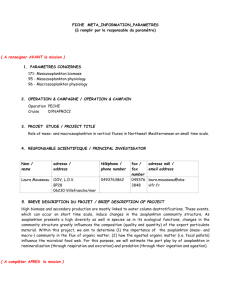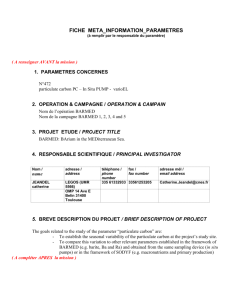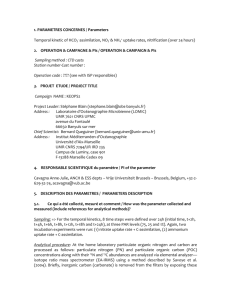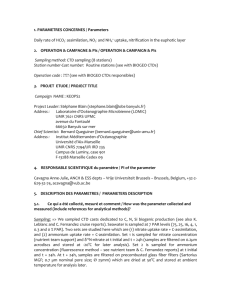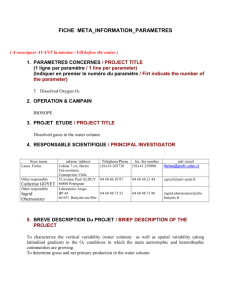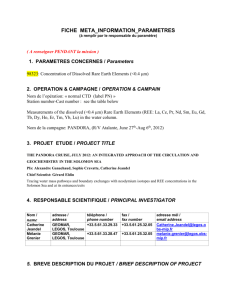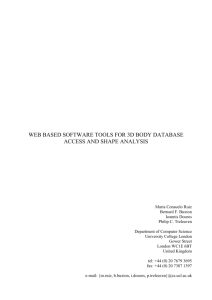Nom
advertisement
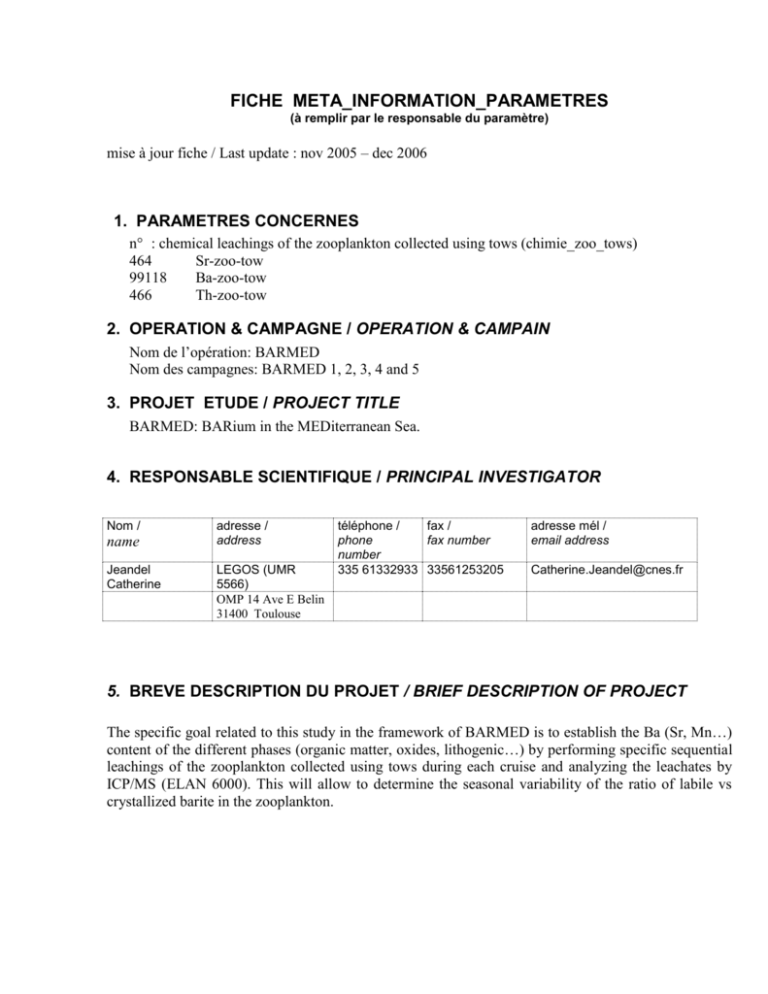
FICHE META_INFORMATION_PARAMETRES (à remplir par le responsable du paramètre) mise à jour fiche / Last update : nov 2005 – dec 2006 1. PARAMETRES CONCERNES n° : chemical leachings of the zooplankton collected using tows (chimie_zoo_tows) 464 Sr-zoo-tow 99118 Ba-zoo-tow 466 Th-zoo-tow 2. OPERATION & CAMPAGNE / OPERATION & CAMPAIN Nom de l’opération: BARMED Nom des campagnes: BARMED 1, 2, 3, 4 and 5 3. PROJET ETUDE / PROJECT TITLE BARMED: BARium in the MEDiterranean Sea. 4. RESPONSABLE SCIENTIFIQUE / PRINCIPAL INVESTIGATOR Nom / name Jeandel Catherine adresse / address LEGOS (UMR 5566) OMP 14 Ave E Belin 31400 Toulouse téléphone / fax / phone fax number number 335 61332933 33561253205 adresse mél / email address Catherine.Jeandel@cnes.fr 5. BREVE DESCRIPTION DU PROJET / BRIEF DESCRIPTION OF PROJECT The specific goal related to this study in the framework of BARMED is to establish the Ba (Sr, Mn…) content of the different phases (organic matter, oxides, lithogenic…) by performing specific sequential leachings of the zooplankton collected using tows during each cruise and analyzing the leachates by ICP/MS (ELAN 6000). This will allow to determine the seasonal variability of the ratio of labile vs crystallized barite in the zooplankton. 6. DESCRIPTION DES PARAMETRES / PARAMETERS DESCRIPTION 6.1. Ce qui a été mesuré et comment / What did you measure and how did you do it (include references for analytical methods)? The content of the cod end (1 liter in volume) was first passed through a 200-µm prefilter to remove as much seawater as possible. The plankton sample was then passed through a 0.65-µm durapore filter (142mm diameter) before undergoing sequential leachings as follows: distilled water rinse, 10% (v/v) HNO3 rinse at room temperature, 3% HCl at 80°C overnight and 50% (v/v) HNO3 at 80°C overnight (Ganeshram et al., 2003, except the 3% HCl leaching to dissolve barite from the Handbook of Chemistry), and finally total acid digestion following the recipe from Landing and Lewis (1991). The first two leachings were performed on-board, immediately after collection. After evaporation, the leachates were diluted in 10 mL HNO3 2%, an internal standard of In/Re (10 ppb) was added, and Ba, Sr, Mn, Th and REE concentrations measured using the ICP/MS Perkin Elan 6000. Stratégie d'échantillonnage / Sampling strategy A vertical tow down to 200m, with a 200-µm net, was performed to collect zooplankton. 6.2. Décrire quels types de données sont nécessaires pour vous compléter votre propre jeu de données avant envoi à la base de données, et estimer le délai avant la disponibilité de vos données pour la base de données / Post-cruise data analysis/treatment required, and the time frame for this The following data will be useful to achieve the interpretation of the mechanism yielding barite formation. For example, acantharians (celestite tests) are suspected to play a role in the barite synthesis. The analysis of the barium (and Sr) concentrations in the different leachates will allow to interpret data acquired independently (eg: suspended Ba, SEM measurements etc…) 6.3. Estimations des erreurs, précision, sensibilité des données / Error estimates, precision and accuracy of the data 7. FICHIERS / FILES 7.1. Nom de fichier de données / file name Tow zooplankton leachings 7.2. Explication des têtes de colonne, des unités et des abréviations utilisées dans le fichier de données / data file structure For each cruise (Barmed 1 to Barmed 5), particulate concentrations of Ba, Sr, and Th, measured after five chemical treatments of the sample (leachings L1 to L5), are given in pmol (10-12 mol) and fmol (10-15 mol) per liter of seawater versus depth (in meters). Errors are given in the same units. Leachings (see § 6.1) L1: distilled water rinse L2: HNO3 1.5 N rinse at room temperature L3: HCl 1 N at 80°C overnight L4: HNO3 at 80°C overnight L5: total acid digestion (Landing and Lewis, 1991) Barmed 1: 15/02/2003 Barmed 2: 23-24/03/2003 Barmed 3: 09-10/04/2003 Barmed 4: 15-16/05/2003 Barmed 5: 24-25/06/2003 8. RESULTATS PRELIMINAIRES / RESULTS 9. REFERENCES BIBLIOGRAPHIQUES Sternberg E., Tang D., Ho T.Y., Jeandel C. and Morel F.M.M. Barium uptake and adsorption in diatoms. Geochimica et Cosmochimica Acta 69 (11), 2745-2752, 2005. Jeandel C., Tachikawa K., Bory A. and Dehairs F. Biogenic barium in suspended and trapped material as a tracer of export production in the tropical N-E Atlantic (EUMELI sites). Mar. Chem., 71, 125-142, 2000. Ganeshram R.S., François R., Commeau J. and Brown-Léger S.L. An experimental investigation of barite formation in seawater. Geochim. Cosmochim. Acta, 67, 2599-2605, 2003. Landing W.M. and Lewis B.L. Analysis of marine particulate and colloidal material for transition metals. In Marine Particles: Analysis and Characterization (ed. D.C. Hurd and D.W. Spencer). Geoph. Monogr., 63, 263-272, 1991.
